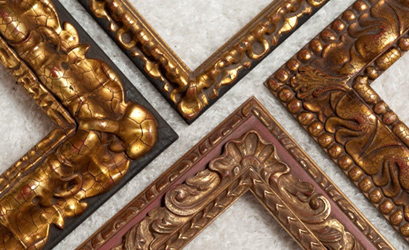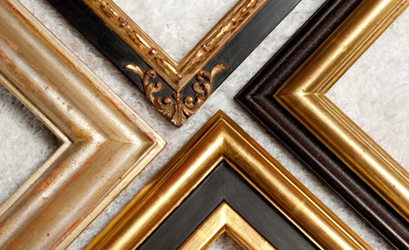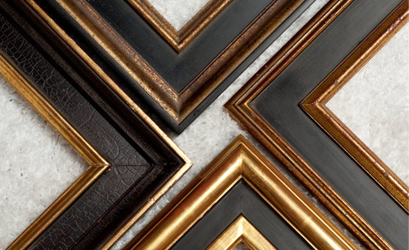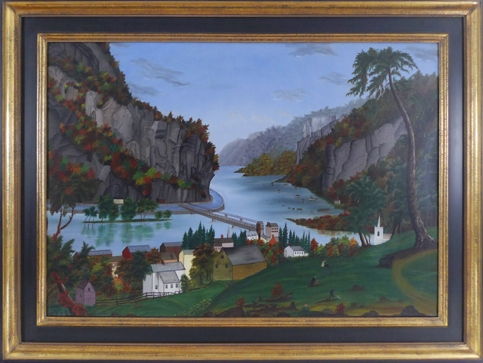custom framing styles » Spanish picture frames
In A.D. 711 Spain was conquered by the Muslims and by the 10th century there was an Islamic Majority. It was not until the 13th Century that Christians reversed the Muslims authority in Spain. This long exposure to Muslim control greatly manipulated the visual language of the Iberian Peninsula. However, soon enough, Byzantine and Carolingian ivories were being imported through the Northern areas of the peninsula and Spain found itself at a confluence of stylistic currents, which merged with the already present styles of Islamic convention producing a mixture of abstract ornaments and heraldic beast medallions and scrolled decorations paralleling French manuscript illuminations.
By the late 13th century, Florence had regular shipping lines running through Mallorca, Barcelona, and Valencia. The result was that Spain adopted rules of practice and set up gilds, which affected the quality, the appearance of frames and altarpieces, and how they were made in Spain.


Although Spain’s styles were inspired by their neighbors, there was always a definite individuality apparent in Spanish frames and altarpieces including square crockets on the gables and pinnacles, wide blossom or flame-like finials dramatic contrasts of polychromy and gilding, frequent use of silver leaf and deep volumetric carving. The opulence of most of the Spanish framework glorifies the rich guilds and city brotherhoods that commissioned them. Also classes of differentiating frame makers which specialized in carving, gilding, or decorating led to an even higher quality of framework.
During the Renaissance, due to pious patronage and popularity of the dramatic baroque style, religious art was in higher demand than portraiture and historical paintings. The baroque style that demanded so much admiration was also uniquely blended with a northern European flair, which often included simple moldings of scotias, astragals and fillers. Other frames influenced by the North also produced the same stained, veneered or painted black cassetta frames found in England, France, and the Low Countries during the 15th and 16th centuries. These examples were often decorated with pastiglia or sgraffito ornament derived from Italian models. Each one of these specimens displays the diffusion of Renaissance motifs, which were spread in various ways throughout Spain.


In the late 16th century, the Plateresque Style was developed in the midst of the Renaissance. The main characteristics include the use of a dense floral, foliate or candelabrum pattern on every panel, column, frieze or pilaster of a classical aedicule. Though the Plateresque Style was but a moment in the history of Spanish frames, it was a key piece of inspiration for both Mannerism and Juan de Herrera’s development of the Herrera Style.
During the reign of Charles I, Michelangelo’s Mannerism arrived in Spain and was accepted quickly due in most part because of Spain’s love of drama and decoration. Characteristics include a wider frieze and framing pilasters, gilt decoration of winged figures, horizontal beams and segmental pediment.
The Herrera Style first appeared as wealth poured into Spain from her colonies and Phillip II ordered for “simplicity of form, severity in the whole, nobility without arrogance, majesty without ostentation.” What was produced was Spain’s own overdue Renaissance style; ironically in a land so attached to opulent decoration, the Herrera style can be described as a sort of pared down classism. Important elements of the Herrera style feature oblong-framed panels and slender straps separated by cabochons or bosses. Through the 17th century, astragals, dentils, chain and egg-moldings, raised squares or lozenges like gems, and chains of alternating short or stretched cabochons appeared in Spanish Herrera frames.

Other Spanish frames of the 17th century are derived from the early Baroque leaf frames and are transmitted through the strong Spanish presence in Italy. It usually combines the Spanish lust for decoration and the sobriety of the contemporary mood and common features included less complex products of mixed influences again from northern Europe and Italy and vigorous gilt leaf moldings. The more expressive frames that were produced embody one of the most ubiquitous and recognizable of Spanish styles, which influenced and was influenced by Neapolitan and Bolognese styles of the 17th century. Examples of this employ Baroque leaf moldings, back-edged trims, sometimes polychromy and additional moldings and the flat often remains black but is decorated delicately with scrolling center and corner panels. The frames offer the perfect setting for paintings presenting the iconic chiaroscuro style of Spanish greats like Caravaggio.
Finally arriving in the 18th century, the Rococo style draws heavy influence from French ornamental motifs and was first introduced into Spain via the Real Academia de San Fernando. True Rococo ornament can be quickly identified by its extravagance and unique from Baroque due to its asymmetrical nature. The most identifiable characteristics include elaborate and flamboyant C- and S- scrolls, floral swags, rocailles, and ogee moldings. Although Spanish framework has always been stimulated by neighbor European countries, and in many cases the effects arrived late to the peninsula, Spain throughout its history continuously maintained its own unique distinctiveness and personality.
MAIN WEBSITE: https://www.OliverBrothersOnline.com
Oliver Brothers Custom Framing 117 Elliott Street, Beverly, MA 01915 617.536.2323

